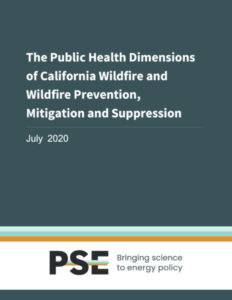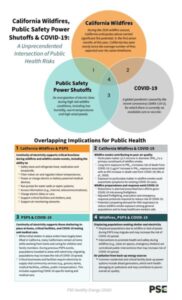School of Public Health at University of California, Berkeley
The western United States is entering what is expected to be an intense wildfire season, fueled by intensifying droughts, reduction in average precipitation and increased frequency of autumn days with extreme fire weather conditions fueled by climate change. In particular, Northern California can expect to see an “above normal” significant fire potential through September, catalyzed by lightning strikes, power lines and high winds in regions where dry fuels like timber and grasses are piling up. To reduce risk of power lines sparking more devastating wildfires, energy providers are working in collaboration with statewide governments to introduce a suite of measures designed to mitigate fire potential on high-risk days, including public safety power shutoffs that will potentially be offset by localized microgrids with battery storage.

Even with statewide and localized efforts geared toward lessening wildfire impacts on local communities and infrastructure, a new report from PSE Healthy Energy finds that wildfires across the Golden State, coupled with public safety power shutoffs and the COVID-19 pandemic, may pose an unprecedented and dangerous intersection of public health risks. Beyond the direct and most severe safety risks posed by wildfire itself, wildfires may introduce public health hazards through environmental exposure pathways (air, water, and soil) and through other pathways that impact mental health. Additionally, approaches to prevent and suppress wildfires and mitigate related impacts in California — such as public safety power shutoffs, prescribed burns, biomass power plants, and chemical fire suppression — may also hold implications for public health. While these approaches are important pillars of wildfire management, each may hold near- or long-term implications for public health that previously had not been thoroughly characterized.
The recent PSE report includes a detailed synthesis of the public health dimensions of both California wildfires and approaches to wildfire prevention, mitigation, and suppression. Wildfire preparedness and response amid the COVID-19 pandemic These elevated wildfire risk conditions are occurring alongside the global COVID-19 pandemic. As no treatment or vaccines for COVID-19 are yet available, frequent handwashing, wearing masks in public spaces, and physical distancing from others are recommended practices aimed at stopping the spread of the virus.
The spread of COVID-19 serves as a threat multiplier for wildfire risks in California, regarding both efforts to prepare for the 2020 wildfire season and emergency wildfire response efforts. COVID-19 risks have complicated the already difficult task of preparing for wildfire season, including efforts to recruit and train fire fighting crews, conduct controlled burns, create fuel breaks, and perform maintenance on aboveground electrical poles and wires. In late March 2020, the U.S. Forest Service suspended controlled burn activities due to the risk of COVID-19 transmission among firefighters. In addition, California state prisons — which typically supply a significant portion of the state firefighting force — have been hard hit by the virus. The State of California typically deploys around 2,200 incarcerated individuals to battle fires, but at least dozens of inmate crews are under lockdown from SARS-CoV-2 outbreaks in their camps, which will be closed until the camps are virus-free. Though the state has compensated for this loss in personnel by hiring an additional 900 new seasonal firefighters, it shows how vulnerable firefighters in base camps may be to the virus. Firefighters are also at risk of other respiratory diseases, and wildfire smoke exposure may make them even more susceptible to COVID-19. The pandemic has again slowed PG&E’s fire-prevention efforts and will continue to result in disruptions in personnel availability and deployment. As of March 31, 2020, PG&E had been far from meeting most of its 2020 wildfire mitigation goals, which included replacing poles and burying powerlines, trimming and removing trees, as well as installing weather stations and high-definition cameras. PG&E had, however, exceeded its emergency generation goal by securing 450 megawatts (MW) of temporary generation for use at substations, critical facilities and other locations. State budgets have been chipped away by the economic fallout triggered by massive shutdowns in response to the pandemic. California leaders had initially anticipated spending billions of dollars in preparation for fires and extreme weather events. In response to COVID-19, California Gov. Gavin Newsom made adjustments to the state budget by reducing funding for home retrofitting measures and increasing funding for the Cal Office of Emergency Services and Cal Fire to hire additional fire personnel and provide resources for fire response. Wildfire emergency response efforts also face pandemic-related complications. Evacuation efforts involve transporting and sheltering displaced populations in indoor environments where many individuals may come into contact with people who they may not otherwise interact with, potentially introducing new pathways of viral transmission. Similarly, on days with heavy wildfire smoke, indoor public spaces with filtered air and air conditioning have been promoted as clean air spaces where individuals can reduce their exposure to wildfire smoke. In response to sheltering concerns in relation to the coronavirus pandemic, the California Department of Social Services and the California Office of Emergency Services have updated their care and sheltering measures by requiring evacuees to receive a health screen when entering a shelter facility. Evacuees will also have access to medical and mental healthcare, and Newsom has announced plans to procure other housing for individuals to shelter in non-congregated places. Nevertheless, these conditions may increase the spread of COVID-19 in affected communities, especially if additional precautionary measures are not taken and if the number of displaced individuals exceeds the capacity of the available resources. Additionally, there may be an added stress on an overburdened healthcare system, paired with a competing demand for respiratory protective equipment during wildfire season that is used to reduce wildfire smoke exposure (i.e. N95 masks) and is also needed by healthcare workers responding to COVID-19 in healthcare settings, particularly as the U.S. Food and Drug Administration has reported detrimental shortages in masks and personal protective equipment. Furthermore, long-term exposure to PM2.5 — fine, inhalable particles found in wildfire smoke — is associated with an increased risk of death from COVID-19 in the United States (a 1 µg/m3 increase in PM2.5 is associated with an 8% increase in death rate). As respiratory symptoms such as shortness of breath and difficulty breathing are primary symptoms in moderate to severe COVID-19 cases, additional exposure to air pollution, particularly wildfire smoke, may exacerbate these symptoms. The findings build on previous evidence that suggests severe outcomes during infectious disease outbreaks, like those seen with SARS and H1N1, are increased with exposure to air pollution. Additionally, systemic health and social inequities contribute to increased risks of both contracting and dying from COVID-19 among racial and ethnic minority populations.
Public safety power shut offs amid the COVID-19 pandemic Work and school are now, perhaps more than ever before, supported by continuous access to electricity at home, as many individuals continue to work from home and schools around the state move to remote learning to reduce the risk of spreading COVID-19. Public utilities are considering the impact of PSPS; for example, energy provider Southern California Edison is in contact with local emergency management to identify vulnerable customers and has installed additional weather stations and high-resolution cameras to identify fire risk areas. In 2019, Californians experienced the first widespread PSPS for wildfire prevention. As outlined in our recent report, PSPS events present challenges that hold implications for public health in residential settings where continuity of electricity is required to safely store and refrigerate food, medication, and breastmilk; filter indoor air and regulate indoor temperature, power or charge electric or battery-powered medical devices; run pumps for water wells or septic systems; access information through the internet and other telecommunication services; charge electric bikes or cars; and support air quality monitoring networks. Additionally, electricity is required to support vital community services (e.g., grocery stores, utilities, public transportation, and medical facilities), including COVID-19 specific testing and medical care. Centralized interventions to promote health and safety during wildfires (e.g., clean air shelters, emergency shelters) may inadvertently increase the risk of COVID-19 spread. Backup power options typically include diesel generators that emit health-damaging air pollutants and greenhouse gases, yet PG&E has expressed the need to deploy up to 450 MW of diesel and natural gas generators to communities affected by PSPS even beyond the 2020 fire season as a “necessary bridge until fossil-fueled alternatives are available.” The California Public Utilities Commission (CPUC) voted to allow the utility to deploy an estimated $170 million in gas-powered generators during shut-offs to keep the lights on despite local resistance and the compounded respiratory risk associated with smoke, pollutants and COVID-19. As Greentech Media concludes, these measures are not sustainable over the long-term and do not “fully leverage the dramatic advances that have been made in renewable energy, battery storage and digitalization.” Even so, distributed clean energy resources are zero-emissions backup power options that can help mitigate health and safety risks associated with PSPS to increase the resilience of communities. Strategic deployment of distributed clean energy resources should prioritize populations and communities that may be particularly vulnerable during wildfire, PSPS, and other natural disasters or grid outages. In that vein, the CPUC implemented Senate Bill 700 and approved changes to the agency’s Self-Generation Incentive Program (SGIP) to incentivize the use of battery storage systems while prioritizing funding for: communities living in high fire-threat areas, communities that have experienced PSPS, low-income and medically vulnerable customers, and critical facilities that support community resilience in the event of a PSPS or wildfire. Amid the compounding health risks posed by wildfire, PSPS, and the recent COVID-19 pandemic, it is critical – perhaps now more than ever – to incorporate the best available public health science into wildfire decision making and policy conversations. For more information, please read the new PSE report: ‘The Public Health Dimensions of California Wildfire and Wildfire Prevention, Mitigation and Suppression’.
